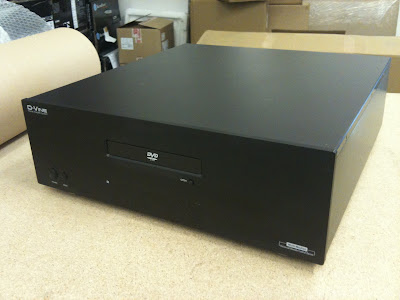Let's look at what's out there. Other than the server, there are 3 HTPCs and their job is pretty much to run Kodi and to server as the front-end to our media which will reside on the replacement server (aka Globemaster). It's actually a bigger job than it appears since all of our TVs are now at least HD with one that's 4K spec. Pushing pixels to those displays is not nearly as easy of a task at what it used to be! So, let's take a look at the players involved.
The whole situation is kind of "a house of cards" really so lets start with the simplest situation. Part of my main A/V system in the upstairs media/game room is the "Hawkeye" HTPC. It's a Asus E350M1-Pro motherboard living inside of an Ahanix D-Vine5 case. That board was AMD's first generation of APUs which combined an actual GPU inside the same die as a CPU. As you can surmise from the bare heat sink w/o fan, it's not very powerful. However, it does the job. If you don't mind the 3 minute boot (on SSD.....ouch) and the 1080p limitation (it's connected to the 55", 4K Sony), then you're good. However, if you compare what those first gen "Llano" chips can do vs. the current ones, it's not pretty.
The reason all this happened in the first place was that, recently, while looking around at other things, I came across this: a Gigabyte F2A78M-HD2. That's an A78 chipset board with a FM2+ socket capable of taking AMD's then new for 2014 "Kavari" series of APUs. These chips 4 generations down the road from my old one, are built on a 28nm process with a 45w TDP. It was also $20! So, after a month of patient watching and waiting, I was able to nail down an A8-7600 processor for $55. What's so special about the this little "Kavari" chip? Here's the thing. This particular SKU can not only be run at the designed 65w TDP, but also at a 45w low power setting. It has 10 total cores, allocating 4 to the CPU and 6 to the R7 GPU giving it plenty of power. Enough so that AMD advertises as capable of driving 4K specs, but in reality their goal is the HD one, which is 1080p at 30fps while gaming with challenging titles. Given that it's going to be an HTPC, that's more than enough. Warts? I wish it had 4 instead of 2 RAM sockets, and it lacks an optical digital out for sound. I use that to send the audio to my home theater receiver for much cleaner decoding, but hey; I can spring for an stand-alone soundcard for that!
What about this? I have 2 other TVs in the house: one in the downstairs living room and one in our bedroom. Our TV watching habits are basically spit between, cable TV, movie watching (via actual media like DVD), and content over the internet. This split varies between the location AND is slowly changing from more cable to more internet with movie watching via media staying the same. Strangely, unlike others, we don't stream Netflix or use Roku, we'll watch TV via the network's sites, Youtube and Kodi (formerly XBMC). So obviously, having a computer connected to these TVs is kind of a need. Some of you might remember my "Viking" build in the Silverstone SUGO SG-08B Lite case. Inside is a very low-powered motherboard, the Gigabyte GA-C847N-D with an onboard Intel Celeron 847 CPU (17w TDP). I do have a DVD drive in there, but not sure why. The onboard graphics seems to do an adequate job, but the engine is the aging "Ivy Bridge" processing. This machine will stay the same.
Last summer, while I was in Taiwan, my brother gave me this. It was one of his spare boards. An Intel DN2800MT mounted in a little plastic generic case. Don't be confused if you've never heard of it, much less seen anything like it. Boards of this type are made for "industry" typically used in computers that run automation of one kind or another, hence the very low-profile everything! Oh, and it's powered by an Intel Atom N2800 which is a dual core processor running at 1.86Ghz drawing 6.5w TDP!!! I've got it running HTPC duties on the 3rd TV, but it struggles some. One of it's issues is that the chipset only allows it to address 4Gb of RAM running on a single channel..... and that's despite the 2 SO-DIMM sockets. It's nice to have versus not having a machine down there, but that's about it.
Enter the Silverstone SUGO SG-05 and Gigabyte GA-B75TN. What? Another weird board? Yes, a $30 (local Craigs List) complete with power supply case and....... wait for it....... $24 board! Quite often, "weird" means cheap! In this case, this one was brand new even. OK, let's look at this MB. It's LGA-1155 meaning anything from the Sandy/Ivy Bridge generation of processors. This not only gives very decent power, but pretty good onboard graphics if the CPU is chosen wisely. On top of which, it has an onboard mSATA socket thus allowing the primary storage to be right there as well. It doesn't even require a regular power supply, capable of using any barrel-plugged outboard adapter between 12 and 19v. There's even an LVDS connector for driving LED/LCD panels. They were part of a spec designed to fit inside the all-in-ones.
When you add it all up, I will have spent about $200 total to update 2 of our 3 HTPCs. They'll all be from the "Core" generation of processors with attendant capabilities. I think we're pretty much set to go!






















